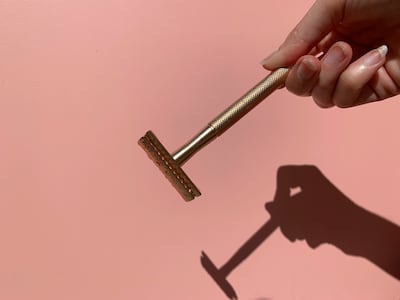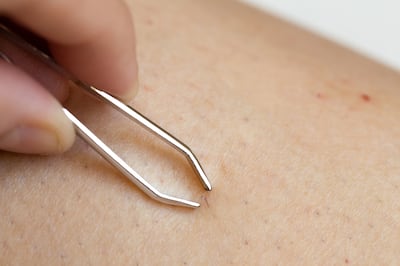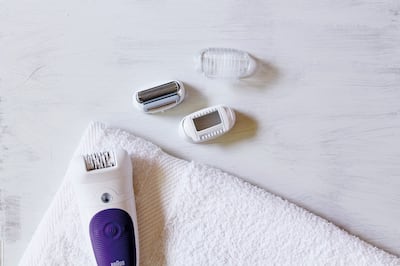Shaving, waxing, tweezing; regardless of the method of hair removal, ingrown hairs as a result are always a possibility. As the hair regrows, ingrown hairs occur when an individual strand curves into the skin, causing a raised, often swollen bump.
In most cases, this isn’t a major medical issue beyond cosmetic concerns and mild skin irritation. But in rare cases, untreated ingrown hairs can pose serious health risks when left untreated, from long-term scarring to bacterial infections.
In 2022, Steven Spinale, an American man in his thirties, was left in a coma after an ingrown hair in his groin led to sepsis, his sister recently revealed in a TikTok post. Spinale was given a 4 per cent chance of survival but is on the way to recovery. While cases like Spinale's are extremely rare, it is still worth being mindful of the condition and knowing when to seek help.
Dr Shireen Emad, a GP in the UK and content creator, explains: “Any untreated infection in the body has the risk of entering the bloodstream leading to sepsis and septic shock so an infected ingrown hair is not different. This is why it is important to see a doctor if there are signs of infection.“
Before it gets to that critical stage, here's what to be mindful of when it comes to ingrown hairs.
Spotting an ingrown hair

Dr Emad adds: “An ingrown hair is when a previously removed hair grows back into the skin forming a little lump that can sometimes hurt or get infected. They usually occur after a hair has been removed by waxing shaving or tweezing, and they are more likely to occur with thick, coarse or curly hair.“
After removing hair from anywhere on the body, you may notice a small bump in the days or even weeks afterwards, and the hair begins to grow. Often inflamed, this could leave the area discoloured (red, brown or purple dependent on skin tone), or could even appear more like a pimple as pus generates in the blister-like spot.
Ingrown hairs – or razor bumps, as they are sometimes known – can also cause itching, burning and general skin irritation, so it may be the case that you can feel an ingrown hair before you spot it.
Depending on the area of the body and the shade of your skin and hair, the hair may also be visible underneath the skin.
Removing ingrown hairs at home

If you find yourself with an ingrown hair, it may be tempting to try and get underneath the skin to remove it yourself; however, that isn't always the best first step. Dr Emad explains: “They can often get better by themselves and if they aren’t bothering you then they don’t need treatment. Cleaning the area with a warm cloth and gently massaging in a circular motion can help release them. An exfoliating scrub can also help to release them, too.“
Poking and prodding at inflamed razor bumps where the hair isn't visible and there isn't any pus, however, may cause further irritation and often the area up to infection by unnecessarily breaking the skin.
If the hair is clearly visible at the skin's surface, however, you may be able to safely remove it at home with sterilised tweezers, cleaning the area immediately afterwards.
Allow the skin adequate time to fully heal before shaving or waxing the area again.
When to seek medical help about an ingrown hair
If you've had a razor bump that hasn't healed for weeks and symptoms are getting worse, it may be time to seek professional assistance. Dr Emad says: “See a doctor if the area becomes red swollen or painful as this suggests it may be infected or an abscess is forming. This can be treated with antibiotic creams or tablets – or it can be removed using a sterile scalpel.“
If this happens, make an appointment with your general practitioner or a dermatologist as the first step, and they can determine the best solution. This can include removing it and or prescribing anti-inflammatory creams, ointments or pills.
Preventing ingrown hairs in the future
Serious health risks aside, ingrown hairs can also be uncomfortable, meaning avoiding them altogether is the ideal solution. As they are a direct response to hair removal, reassessing your methodology may be step one.
For example, waxing and tweezing are thought to result in fewer ingrown hairs in comparison to shaving, as it removes hairs from the follicles. Hair removal cream can also cause less irritation than both the previous, while also exfoliating the surface layer of the skin. If your hair is particularly prone to irritation after hair removal, long-term solutions such as laser hair removal may also help.

Beyond your go-to hair removal technique, your routine before and after can also impact your likelihood of pesky ingrowns. These include:
Using warm water when shaving
Warm water can help to open the pore and create less friction when shaving, limiting irritation.
Not shaving or removing hair every day
Again, leaving space between hair removal sessions can be easier on the skin and avoid irritating already inflamed skin.
Ensuring razor heads are clean and replaced often
Hair removal can create small cuts in the skin, opening it up to possible infection. To minimise this, ensure removal tools are clean and sterilised if needed, and replaced regularly.
Exfoliating skin regularly
Exfoliating – with skincare products that include exfoliating enzymes, texture scrubs or tools such as shower mitts – can remove surface-level dead skin, minimising the chances of skin growing over re-emerging hair follicles.
Using a post-removal soothing cream
Keep skin calm after putting it through the hair removal process with an anti-inflammatory cream, or specially made post-shaving lotion.







